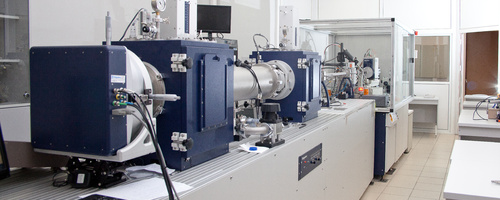About Facility
X-Ray scattering is the one of the most powerful and the most frequently used methods to obtain the protein structure. The X-Ray Diffraction (XRD) on the protein crystals can give the information about protein structure with atomic resolution and the Small Angle X-Ray Scattering (SAXS) can give us the protein shape without crystallization, close to in-vivo state. The main problem of these methods is the low X-Ray contrast for biological objects that means it’s necessary to have an extremely powerful source of X-Rays. Our X-Ray platform is based on Rigaku MicroMax-007HF microfocus rotating anode X-Ray generator with copper anode, X-Ray wavelength is 1.54Å.
Our expertise can be provided to support groups with no dedicated crystallographers at all stages from inception to final structure solution.
On the XRD part VariMax-HF confocal optical system is installed and gives us about 8×1010 particles/sec/mm2 on the 0.2-0.3mm diameter beam. Crystal holds on high-precise 4D goniometer with rotation axis about ω-axis and maximum possible resolution of 0.84Å and cooled with Oxford Cryosystems Cryostream with temperature up to 100K. Arcless goniometer provides housing for crystals in cryoloops and N2-cryostream maintains the cryoconditions. For detection of scattered photons Saturn 944HG cooled CCD detector is used, which have 2048x2048 pixels on 94x94mm imaging area. All of this give us the possibility to get the protein structure with resolution up to 1.5Å.
For SAXS measurements we use the confocal Max-Flux SAXS optic with SMAXS-3000 pinhole system which forms the X-Ray beam with 0.4mm diameter, about 10-4 rad angle divergence and flux about 4×108 particles/sec/mm2. Using of two sample chambers give us the q-range 0.005-1.2Å-1 which means possibility to detect objects about 5-1000Å size. Scattered photons are detected by extra-low noise gabriel-type gas detectors with 1024×1024 pixels 200 mkm size. In addition, sample environments have possibilities to do WAXS experiments, temperature control cells from -50 to 300℃ with +/- 0.1℃ precision, Grazing Incidence/Reflectivity module, Tensile stage and Shear cell.









